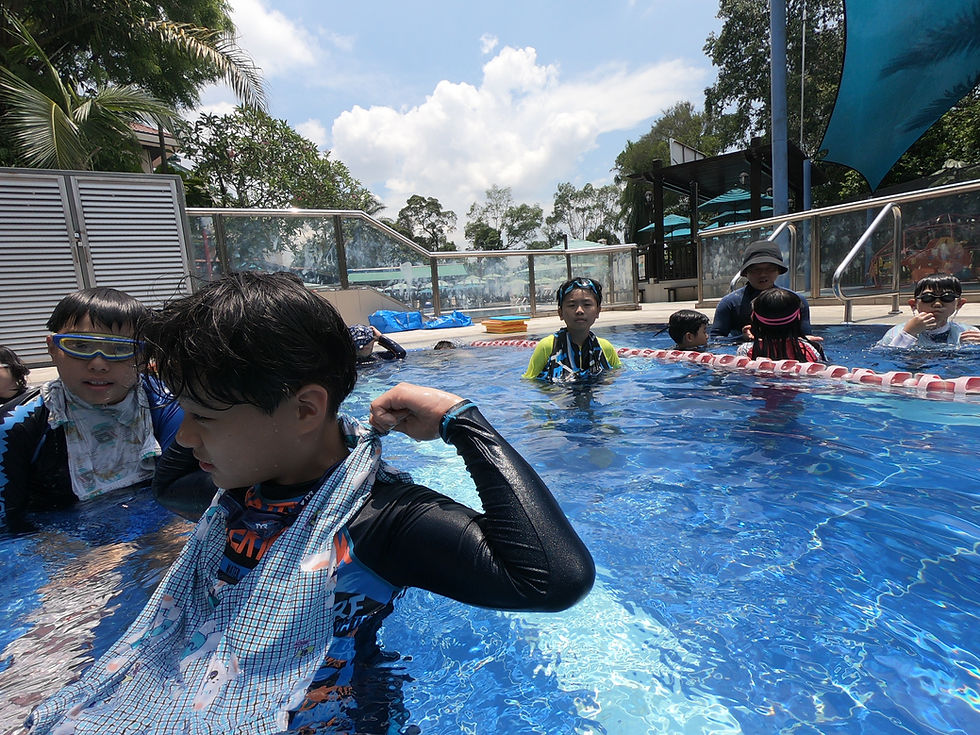How to Avoid Panic During Open Water Swims
- SG Sink Or Swim

- Jun 10, 2025
- 3 min read

Open water swimming is an incredible experience—freedom, scenery, and the rush of racing in nature. But even seasoned pool swimmers can experience panic in the open water. Cold water, murky visibility, choppy waves, or simply being far from shore can trigger anxiety or even full-blown panic attacks.
The good news? With the right mindset, preparation, and training strategies, you can stay calm, focused, and in control. This guide shares practical tips on how to avoid panic during open water swims, whether you're a triathlete, open water racer, or casual swimmer.
🧠 Why Panic Happens in Open Water
Panic during open water swims is common—and normal. It can be triggered by:
Sudden cold water shock
Difficulty breathing or swallowing water
Claustrophobia from wetsuits or dark water
Losing sight of buoys or other swimmers
Feeling overwhelmed by the vastness of open water
Unexpected waves or currents
The key is not to fight the feeling, but to manage it with awareness and tools.
✅ 12 Proven Tips to Avoid Panic in Open Water Swimming
1. Start Slow and Shallow
Don’t jump into long, deep swims right away. Start in shallow, calm water close to the shoreline.
Practice entering slowly and floating on your back
Build confidence with 10–25 meter swims before going longer
✅ Confidence builds through gradual exposure.
2. Acclimate to Cold Water
Cold water can cause involuntary gasping and trigger panic. Train your body to handle it:
Splash your face and back of your neck before diving in
Practice short dips in cold water regularly
Use a wetsuit if needed for insulation
✅ Acclimation helps reduce the “shock” response.
3. Practice Breathing Control Drills
Anxiety affects breathing—so take control of it before panic sets in:
Inhale through your nose, exhale slowly through your mouth
Try box breathing (inhale 4 counts, hold 4, exhale 4, hold 4)
Do breath-hold drills in the pool to build calm under pressure
✅ Controlled breathing = calmer mind.
4. Float First, Then Swim
If panic hits mid-swim:
Roll onto your back and float to regain control
Tread water and focus on slow breathing
Signal for help if needed—but don’t rush to swim again until you’ve calmed
✅ Knowing how to stop without stress is a powerful tool.
5. Practice Sight-and-Swim Techniques
Losing direction can trigger disorientation and panic.
Lift your head every 6–8 strokes to sight a landmark
Practice sighting in pool lanes or open water ahead of your event
Use large, visible objects like trees or buoys for better orientation
✅ Staying on course reduces fear of the unknown.
6. Train with a Swim Buddy or Group
Swimming alone increases risk and anxiety.
Join an open water swim group or train with a friend
Take turns leading and trailing so you learn to follow and navigate
Encourage each other before and after the swim
✅ Support reduces isolation and boosts confidence.
7. Use Familiar Equipment
Race-day is not the time to try new gear. Stick with:
Your usual wetsuit, goggles, and swim cap
Anti-fog spray and tinted lenses for better visibility
A swim buoy for added safety and peace of mind
✅ Comfort and familiarity reduce mental stress.
8. Have a Mental Plan for Panic
Don’t just hope panic won’t happen—plan for it.
Know what you’ll do: "Float. Breathe. Look up. Re-center."
Create a mantra like “Calm. Strong. In control.”
Remind yourself: panic is a feeling, not a fact
✅ Mental preparation can override fear responses.
9. Simulate Race Conditions in Training
If your goal is an open water race, simulate conditions:
Swim in the ocean or lake with chop or current
Practice mass starts and close swimming
Mimic race-day gear, hydration, and warm-up routines
✅ The more real your training, the less fear on race day.
10. Warm Up Thoroughly
Going from dry land to sudden effort can spike anxiety.
Jog or do light mobility before getting into the water
Swim 100–200 meters easy before starting your main effort
Splash and submerge to adjust gradually
✅ A good warm-up calms the body and mind.
11. Visualize a Successful Swim
Before your swim, close your eyes and imagine:
Entering calmly
Gliding smoothly through the water
Handling discomfort with control
Finishing strong and relaxed
✅ Visualization builds confidence and reduces unknowns.
12. Know When to Stop
If panic overwhelms you:
Don’t push through blindly
Float, call for help, or swim to shore calmly
Remember: one swim doesn’t define your ability
✅ There’s no shame in stepping out safely.
🏁 Final Thoughts
Panic in open water is not a weakness—it’s a signal. And like any skill, open water calmness can be trained, practiced, and mastered. With preparation, gradual exposure, and breathing control, you can turn fear into focus and hesitation into confidence.
Remember: open water swimming is a journey. Go at your pace, trust your preparation, and most importantly—stay safe and self-aware.





Comments